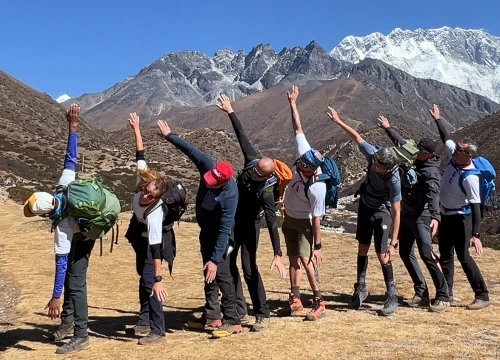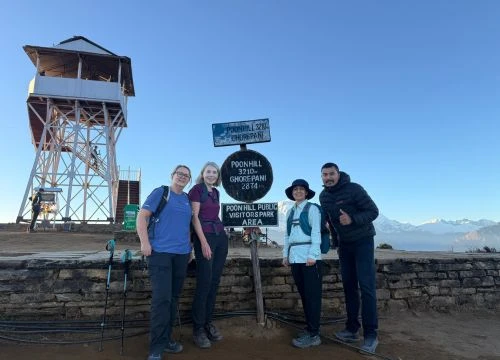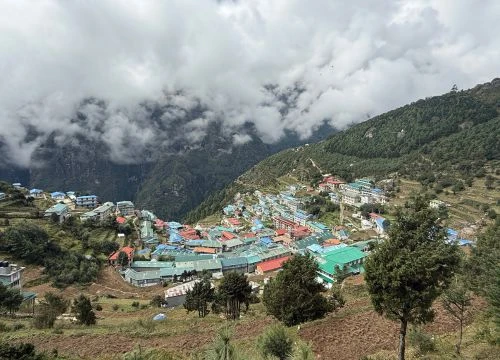Famous peaks like Everest, K2, and Kanchanjunga, including Lhotse, Makalu, Cho Oyu, Dhaulagiri, Manaslu, Nanga Parbat, Annapurna I, Gasherbrum I, Broad Peak I, Gasherbrum II and Shishapangma are higher than 8,000 meters, which are included in the list of the 14 tallest mountains in the world. These magnificent mountains, which are part of the Himalayan and Karakoram mountain ranges, are among the most difficult and breathtaking climbing locations on the earth that are drawing explorers and mountaineers from all over the world. The highest peak in the world, Mount Everest is renowned for its dangerous landscapes and adverse weather, making climbing it a highly desirable achievement. K2, the world's second-highest mountain and one of the most difficult to reach, challenges climbers with steep slopes. Kanchenjunga is known for its spectacular beauty and complex route that connects Nepal and India. Lhotse, which lies next to Everest, is a tough climb recognized for its steep face and technical challenges. Makalu, located in the middle of the Himalayas, is a difficult climb with steep pitches. Cho Oyu is less challenging than the other mountains in the area which makes it a desirable option for mountaineers. Dhaulagiri is famous for its confined location and difficult terrain which provides a real wilderness experience. The eighth-highest peak in the world, Manaslu, can only be climbed with technical prowess and stamina. Nanga Parbat is known for its severe avalanches and steep slopes giving it the nickname of "Killer Mountain." Despite not being the highest, Annapurna I is one of the deadliest peaks due to its risk for avalanches and challenging climbing. The Karakoram Range's Gasherbrum I is a difficult climbing with extremely challenging ice and rock aspects. Broad Peak is distinguished by its dramatic pyramid form and challenging ascent. Gasherbrum II, another peak in the Karakoram Range that requires technical climbing skills and determination. Shishapangma, the only 8,000-meter summit wholly located in Tibet, is a less-popular mountain that offers hikers a peaceful option.
14 Highest Mountain in the World
Table of Contents
14 highest mountains in the world
Everest (8,848m/ 29,028 ft)
Mount Everest is the highest mountain located between Nepal and Tibet at 8,848 meters (29,028 ft) which is considered to be the highest point on the Earth. Mount Everest lies 28 degree north of the equator. The coldest temperatures of the year occur from the middle of December onward which is 15th until the end of January with temperatures at the summit averaging -37 degree Celsius (-35F) while those at Everest Base Camp average temperature is -17C(1.4F). Temperatures warmth comes during spring months of April and May although nights are still chilly and cold. December/January are the cold months and the best trekking is in between March to May and October to November, when the climate is moderate. Everest Summit is the windiest location of the Earth. Despite the fact that 17 different routes have been established to the peak of Everest, only one of the two are used by the majority of climbers. The Southeast Ridge, established in 1953 by Tenzing Norgay and Edmund Hilary, extends from Nepal. The North Ridge is where George Mallory vanished from Tibet in 1924, years before a Chinese team ultimately finished the climb in 1960.
K2(8,611m/28,251ft)
After Everest (8,048 meters), K2 (8,611 meters/28,251 feet), also known as "Chogori," is the second-highest mountain in the world which is located on the border of China and Pakistan in the Karakoram mountain range. K2, sometimes known as the "Savage Mountain," is widely regarded as one of the most challenging of the world's 8,000-meter peaks, with a death rate historically among the highest of all 14 summits, alongside Annapurna I (8,091 meters) and Nanga Parbat (8,126 meters). K2 is one of the coldest spots on the planet, with winter temperatures frequently falling below -40 degrees Celsius. Temperatures at the peak can remain far below freezing even in the summer. The weather on K2 is unpredictable, and the risk of avalanches and rock falls are the other two key elements that contributed to the expedition's failure. In K2, Clear skies can quickly transform into blizzards or whiteouts, increasing the risk for climbers.
Kanchenjunga (8,586/28,169ft)
Kanchenjunga is the world's third-highest mountain, reaching at 8,586 meters (28,169 ft) above sea level. It is situated in the Himalayas between Nepal and the Indian state of Sikkim. Kanchenjunga, like many other high mountains in the region, faces challenging and unpredictable weather conditions. The summit of Kanchenjunga can be reached via four different climbing routes, three of which originate in Nepal from the southwest, northwest, and northeast and one from northeastern Sikkim in India. Only three times have attempts to take the Sikkim route from the northeast proven successful. This route has been closed since 2000 since the Indian government has outlawed expeditions to Kanchenjunga. The Kanchenjunga region is not frequently explored by trekkers because to its distant location in Nepal and the challenges involved in reaching it from India. As a result, much of its unspoiled beauty has been preserved. Sub-zero temperatures are frequent even during the climbing season on K2, where temperatures frequently drop below zero. The winter time may bring with it some incredibly chilly temperatures.
Lhotse (8,516m / 27,940ft)
The Tibetan Autonomous Region of China and Nepal share a border with Lhotse, the fourth-highest mountain in the world which reaches at 8,516m (27,940ft). It is located close to Mount Everest, the highest mountain in the world, and is a part of the same mountain range. The way to Everest and Lhotse is same till 7800m. To climb Mount Lhotse, 4 separate camps have been established above base camp. The final way to the summit is through the icy and rocky gully from camp-4. Extreme cold, strong winds, and low oxygen levels because of the mountain's great altitude are some of the difficulties that come with climbing Lhotse. Particularly the South Face is known for its technical challenges and avalanche-prone terrain. Throughout its history, Lhotse has witnessed numerous remarkable climbers and successful ascents. Some mountaineers have summited both peaks in a single expedition to complete the "Lhotse-Everest" double.
Makalu (8,481m / 27,825ft)
Makalu is 8,481 meters (27,825 feet) tall, making it the fifth-highest mountain in the world. On the China-Nepal border, it is situated in the Mahalangur Himalayas, southeast of Mount Everest. On Makalu, there are a number of well-established routes, such as the popular standard route from the north and the West Ridge path. One of the hardest and most technically difficult routes in the world is the West Ridge path. The Makalu-Barun Valley, which is close to the mountain and is a protected conservation area, is well renowned for its great biodiversity.
Cho Oyu (8,201m / 26906ft)
Cho Oyu is the sixth-highest mountain in the world at 8,201 m (26,906 ft) above sea level, located on the boundary between China's Tibet Autonomous Region and Nepal. It is situated west of Mount Everest in the Himalayas and is a member of the Mahalangur range. One of the 8,000-meter peaks nearest to Everest is Cho Oyu. It is a well-liked option for climbers wishing to take on one of the highest mountains in the world because it is one of the "easier" 8,000-meter summits to scale. Cho Oyu poses major challenges because of its tremendous altitude, chilly weather, and strong winds even though it is less technically difficult than some of the other 8,000-meter summits. It is advertised as a "trekking peak" that climbers with high fitness but little prior mountaineering expertise can reach. As the eight-thousander with the lowest death-summit ratio (125th of Annapurna's), Cho Oyu is regarded as the simplest. It is the second-most-climbed 8,000 meters peak behind Everest, which is the most well-known because of its height. Cho Oyu has a number of well-known routes, including the southwest face and the northwest ridge. The most utilized and straightforward path is the conventional one that starts from the northwest side.
Dhaulagiri (8,167m / 26,795ft)
Dhaulagiri is located at an altitude of 26,795 feet (8,167 meters) above sea level. It is an area of Nepal's Dhaulagiri mountain range, which is located west of the Annapurna range, near the town of Pokhara. Dhaulagiri II, Dhaulagiri III, and Dhaulagiri V are simply a few of the famous peaks that make up the Dhaulagiri massif. A well-known trip that round the Dhaulagiri massif is the Dhaulagiri Circuit trip. It provides breathtaking views of the mountain and the peaks nearby.
Manaslu (8,163m / 26,781ft)
Manaslu is the eighth-highest mountain in the world, standing at a height of 8,163 meters (26,781 feet). It is located in Nepal's west central region, in the Mansiri Himal, a section of the Nepalese Himalayas. It is the tallest peak in Nepal's Gorkha District. There are numerous trekking alternatives in the Manaslu region. The 177 km (110 mi) popular Manaslu trekking path skirts the Manaslu massif over the pass and descends to Annapurna. Ten peaks higher than 6,500 meters (21,325 feet) can be seen on the way, some of which are over 7,000 meters (22,966 feet). The Manaslu Circuit Trek is a popular trekking route that circles the Manaslu massif. The region's natural and cultural resources are protected by the Manaslu Conservation Area Project (MCAP). It encompasses a huge region and has pristine sceneries as well as a variety of wildlife species.
Nanga Parbat (8,125m / 26,660ft)
After K2, Nanga Parbat is Pakistan's second-highest peak and the ninth-highest mountain in the world. The elevation of Nanga Parbat is 8,125 meters (26,660 ft) above sea level. Because of its known to be difficult and fatal climbing history, it is frequently referred to as the "Killer Mountain". One of only two mountains on Earth, Nanga Parbat, is ranked ninth and fourteenth, respectively, among the tallest mountains in the world and the most visible mountains. The renowned Mount Everest, which comes in first on both rankings, is the other mountain. After Mount Everest, Nanga Parbat is the Himalayas' second-most visible peak. One of the world's tallest mountain faces is Nanga Parbat's Rupal Face. The top reaches more than 4,600 meters (15,000 ft) above the valley floor.
Annapurna I (8,091m / 26,545ft)
In the Annapurna range of the Nepal Himalayas, Annapurna I is one of the most famous peaks in the Himalayas. With an elevation of 8,091 meters (26,545 feet) above sea level, it ranks as the 10th tallest peak in the world and is renowned for its difficult and dangerous climbing routes. The Annapurna Range, a portion of the Himalayas in north-central Nepal, includes Annapurna I. Annapurna I was the first peak over 8,000 meters (26,200 feet) to be climbed. Annapurna I has consistently been rated as one of the most dangerous of all eight-thousand meters peaks, along with K2 and Nanga Parbat.
Gasherbrum I (8,080m / 26,509ft)
One of the known Himalayan peaks in the Karakoram Range is Gasherbrum I, usually referred to as G1. With an elevation of 8,080 meters (26,509 feet) above sea level, it is the eleventh-highest mountain in the world. Part of the Gasherbrum massif, which also contains a number of other significant peaks, Gasherbrum I is located in Pakistan's Baltistan province. The second-highest and most well-known mountain in the Gasherbrum massif, Gasherbrum II (G2), is one of the several peaks that make up the Gasherbrum massif. Because they are so close together and have similar heights, G1 and G2 are frequently referred to as the "twin" or "sister" peaks.
Broad Peak (8,051m / 26,414ft)
One of the prominent peaks in the Himalayan Karakoram Range is Broad Peak, often known as K3. With an elevation of 8,051 meters (26,414 feet) above sea level, it is the 12th tallest mountain in the world. In Pakistan's Baltistan region, close to the Chinese border, is where you'll find Broad Peak. With a summit that is nearly 1.5 kilometers (7.8 miles) long, the peak's name accurately characterizes its physical attributes and gives it the impression of a "broad peak." Because of its proximity to the Gasherbrum massif, Broad Peak is frequently summited alongside other adjacent summits like Gasherbrum I and Gasherbrum II. Because of their close nearby regions, expeditions can climb several summits in a single trip. The usual approach, which follows the southwest ridge, is the most popular climbing route up Broad Peak. The climbing on this route consists of ice, snow, and rock. The west ridge and the north ridge are two additional ways on the mountain, however they are less popular.
Gasherbrum II (8,035m / 26,362ft)
Gasherbrum II, frequently abbreviated as G2, is a major Himalayan mountain in the Karakoram Range. It is the world's 13th tallest peak, rising 8,035 meters (26,362 ft) above sea level. Gasherbrum II is located in Pakistan's Baltistan area, close to the Chinese border. Gasherbrum II is a member of the Gasherbrum massif, along with Gasherbrum I (G1), Gasherbrum III (G3), and Gasherbrum IV (G4). Because to their proximity and comparable heights, Gasherbrum I and Gasherbrum II are commonly referred to as "twin" or "sister" peaks. G2 is a popular choice for climbers because to its relatively easier ascent compared to some of the regions other 8,000-meter peaks.
Shishapangma (8,027m / 26,335ft)
Shishapangma is located in the Himalayas, especially the Langtang Himal subrange in Tibet, China. With an elevation of 8,027 meters (26,335 ft), Sishapangma is the 14th tallest summit in the world. Sishapangma, unlike several other eight-thousand meter peaks, is comparatively approachable in comparison to peaks in nearby locations. It is totally within Tibet and does not need crossing into Nepal or Pakistan. Climbers have several options on Sishapangma, but the North-West Ridge is the most popular. Because this route is regarded less technically difficult than some other eight-thousanders, Sishapangma is a relatively common choice for climbers trying to climb an 8,000-meter mountain for the first time.




